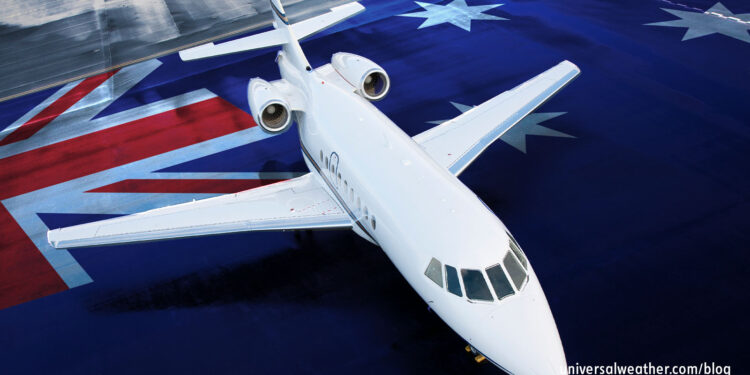Australian BizAv Ops Checklist – Part 3: Curfews, Noise, Security, and ADS-B

This is a post by author Tony King. Tony is the managing director at Universal Aviation Australia – Sydney. Tony is an expert on business aircraft operations in Australia and can be contacted at tonyking@universalaviation.aero.
This business aviation blog post continues from our article last week, entitled “Australian BizAv Ops Checklist – Part 2: Permit & Slot Considerations.”
The good news from Australia is that certain airports have loosened curfew restrictions, which were previously based on model/type of aircraft. Recent Australian regulatory changes have made late-night operations much more manageable, particularly at airports like Sydney Int.’l (YSSY) and Adelaide (YPAD).
The following is an overview of what you need to know:
1. Changes to airport and noise curfews
Only Stage 3 and above aircraft are permitted to operate to Australia. Recently, the Australian Department of Infrastructure and Regional Development added more than 80 General Aviation (GA) business jet models to the list of aircraft permitted to operate during late-night curfew hours – 2300-0600 local – at both YSSY and YPAD. This is a positive development and significantly expands the lists of permitted aircraft that had previously been published for YPAD in 2000 and YSSY in 2005. The new list of aircraft models permitted to operate during late-night curfew hours includes Bombardier Challenger 600s, Dassault Falcon 7X, Embraer 500/505, and Gulfstream 650ER. This list is now identical for both YSSY and YPAD, which was not the case previously, making travel logistics simpler for operators.
2. Night closures/curfews
For YSSY and YPAD, late-night noise curfews are based on weight of aircraft. GA aircraft of up to 75,000 lbs. (34,000 kg) actual takeoff weight, with Stage 3 noise certificates, may operate during late-night hours at both YSSY and YPAD. There’s been some confusion among operators regarding weight cutoffs for curfew hour operations. If the maximum takeoff weight of an aircraft, such as a Global or Gulfstream V series, is over 75,000 lbs., but actual takeoff weight is at or under 75,000 lbs., then operation may be permitted during curfew hours. Note that both Gold Coast (YBCG) and Melbourne Essendon (YMEN) are closed during late-night hours. It’s always recommended to confirm applicable night and noise restrictions, on a case-by-case basis, with your 3rd-party provider.
3. Security mandates
By regulation all charter operators, and some private non-revenue operators, must have an approved Transportation Safety Program (TSP) prior to travel to Australia. The TSP program is overseen by the Department of Infrastructure and Regional Development, to which special security forms must be submitted. Department authorities advise that it usually takes up to 60 days to process a TSP. A ground handler or 3rd-party provider can assist with this process so long as you give him or her authority in writing to do so. Although TSP requirements are aimed mainly at charter operations, they also apply in some cases to higher-frequency private operations to Australia. It’s important to confirm TSP requirements, in advance, with your 3rd-party provider.
4. ADS-B mandates
For operations over Australia at or above Flight Level (FL) 290, aircraft must be Automatic Dependent Surveillance-Broadcast (ADS-B)-equipped and -certified. Currently, Australia’s Civil Aviation Safety Authority (CASA) allows for temporary exemption from ADS-B mandates for certain operators in certain airspace, mainly along the eastern coast. Submission of a completed Notification Form (208) will allow operations in the exempted airspace. Note that this exemption expires on Dec. 11, 2015, with no extensions likely at this time. After this date all operators must be ADS-B-equipped/certified in order to fly through Australian airspace at or above FL 290. For more information on current ADS-B exemptions, please see this CASA website.
5. Additional reading: Australian Operations Checklist – Series Index
Note: Links will be updated as articles are published.
- Part 1 – Airport considerations
- Part 2 – Permit & slot considerations
- Part 3 – Curfews, noise, security & ADS-B
- Part 4 – CIQ and documentation
Conclusion
Don’t get trapped in terms of ADS-B requirements and TSP mandates when operating to Australia – particularly as a charter flight. Ensure that you allow yourself the needed time for requests to be processed and ensure that all documentation and equipment are in order for travel to Australia.
Questions?
If you have any questions about this article or would like assistance planning your next trip to Australia, contact me at christinevamvakas@universalaviation.aero.




